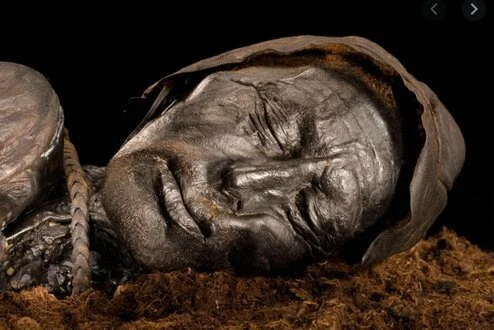What happens when a human body decomposes?
Warning. Contains some disturbing images.
Finding a dead body in our national parks and other wilderness areas can be a messy business. Fluid can be leaking from orifices, limbs may twitch in a lifeless body, the stench can be overwhelming, and eyes will open or remain partially open as the various muscles stop working. Following death, the blood pools, the body temperature drops, and muscle stiffening or “rigor mortis” start. For pathologists examining bodies to determine a cause of death, it is a job they become hardened to; for others, like attending police or those who discovered the body, it can be a very distressing experience.
Human decomposition is a natural process involving the breakdown of tissues after death. The rate varies due to several factors, including temperature, moisture, acidity and oxygen levels, cause of death, and body position.
On death, blood stops circulating through the body, and red blood cells sink and settle in the lowest parts. Blood vessels in the skin become distended with fluid, a process called Hypostasis. So, the skin initially looks pink. Where the body is pressed against an object such as a bed, there are areas of white where the blood cannot drain. Hypostasis finally disappears when decomposition starts.
What are the four stages of human decomposition?
Stage one of body decomposition - Autolysis
The first stage of human decomposition is called autolysis, or self-digestion, and begins minutes after death. Soon after the heart stops beating, the cells in the body become deprived of oxygen, and because carbon dioxide levels increase, their acidity increases as the toxic by-products of chemical reactions accumulate inside them.
Enzymes start to digest cell membranes and then leak out as the cells break down. Because normal blood circulation and breathing stop, the body has no way of getting oxygen or removing wastes.
Damaged blood cells exit the broken vessels and, because of gravity, settle in the veins and capillaries, discoloring the skin.
The autolysis process usually begins in the liver, which is high in enzymes, and in the brain, which has high water content and then spreads around the body.
The body’s temperature also begins to drop on death until it reaches the same level as its surroundings. Then, a condition called “rigor mortis” begins. The stiffness of death begins, starting in the eyelids, jaw, and neck muscles, before it spreads to the torso and then the limbs. When a body is alive, the muscle cells contract and relax due to the actions of two filamentous proteins, called actin and myosin, which slide along each other. After death, the cells are depleted of their energy, and the protein filaments become locked in place. This causes the muscles to become rigid and the subsequent stiffness.
Small blisters filled with nutrient-rich fluid appear on internal organs and the skin’s surface. The body will appear to have a sheen due to ruptured blisters, and the skin’s top layer will begin to loosen.
Stage two of body decomposition - Putrefaction
Within a week of death, depending on weather and microenvironment, body cavities will burst, and tissues will liquefy. The process starts in the intestines, the stomach, then the liver, heart, lungs, and air passages, then the brain, kidney and bladder. The skin is usually last.
Once autolysis is underway and bacteria have started to escape from the gastrointestinal tract, putrefaction begins 3-4 days after death. This means that cells and soft tissues break down even further, mainly into gases and liquids. The microorganisms and bacteria produce extremely unpleasant odors and these can often alert others that a person has died and can linger long after a body has been removed. These Bacteria spread in the veins and often migrate to the arms and thighs. Fern-like patterns on veins close to the surface are therefore evident in these areas.
Leaked enzymes from the first stage begin producing many gases. The sulfur-containing compounds that the bacteria release also cause skin discoloration. Due to the gases, the human body can double in size. In addition, insect activity can be present. The skin begins to blister, red and brown fluids are released, and eventually, the skin sloughs off. Gas released within the body causes swelling of the breasts, face, and genitals. The body becomes dark and enlarged. In the outdoors, flies lay eggs, and larvae take hold. Domestic and wild animals can contribute to bodily breakdown. If someone dies in the presence of a pet dog, starvation can sometimes lead to the pet eating its owner!
Rings of muscle lose tone, so depending on the angle of the body and the individual’s organs, urine and feces may leak and also semen. So, semen outside the body does not necessarily mean there was sexual activity before death. Gastric content is regurgitated in 25% of all deaths.
Hair follicles die with the rest of the skin, so it is not true that someone’s hair keeps growing after they die.
Stage three of body decomposition - Active Decay
Fluids released through orifices indicate the beginning of active decay. Organs, muscles, and skin become liquefied, and body mass decreases. When the body’s soft tissue decomposes, hair, bones, cartilage, and other byproducts of decay remain.
Stage four of body decomposition - Skeletonization
Skeletonization occurs when the last of the body’s soft tissues have decayed or dried to the point that the skeleton is exposed. Because the skeleton has a decomposition rate based on the loss of organic (collagen) and inorganic components, there is no set timeframe when skeletonization occurs.
Other mechanisms of decomposition - Adipocere and Mummification
Adipocere body
What is Adipocere?
Adipocere is the product of the decomposition of fat or so-called adipose tissue. It forms in both surface and subsurface conditions and embalmed and unembalmed bodies. It is known as “corpse wax” or “wax of graveyards”. The formation can take around six months but can be accelerated by maggot infestation or hot weather. The rancid smell is terrible initially when the fatty tissue starts to change, but when it becomes gray and more solid and less smelly later. On occasions, its presence can indicate causes of death. The process usually requires water or damp earth. And the depth of a grave and soil type can all impact the process.
Mummification. Tollund Man, who was found in Denmark
What is mummification?
In places with hot, desert-like conditions, mummification can occur. It can also occur in cooler climates when someone who is thin dies in a dry and drafty place like an attic or chimney. Bodies of newborns are generally sterile and less prone to putrification. Many bodies of newborns have been found in attics when it was socially unacceptable to ask for an abortion or the baby was stillborn.
Exclusive articles for members of StrangeOutdoors that are not available elsewhere on the site.
See the latest Exclusive members-only articles on StrangeOutdoors.com
Read more Q&A’s on StrangeOutdoors
Weird vibes in the wilderness - what causes them?
What happens when a human body decomposes?
How is Forensic genealogy helping on wilderness disappearance cold cases?
Why are people found in the backcountry with their clothes missing?
What are good books and audiobooks on missing people in the great outdoors?




